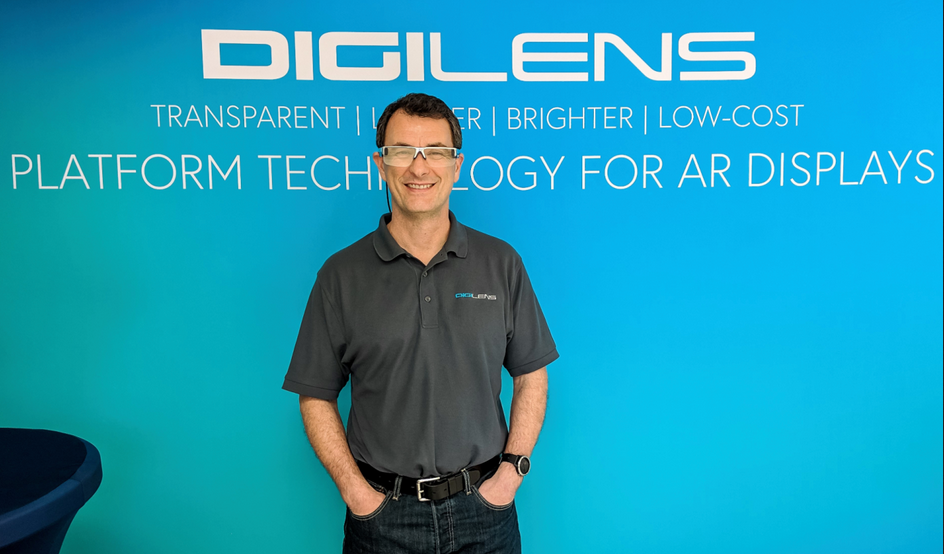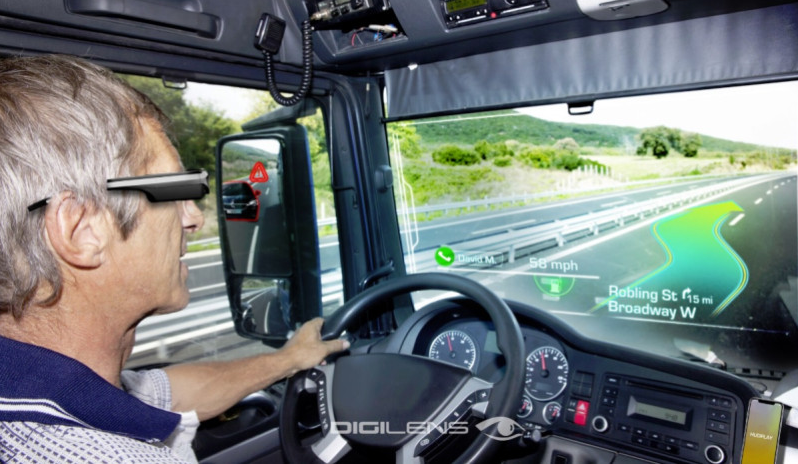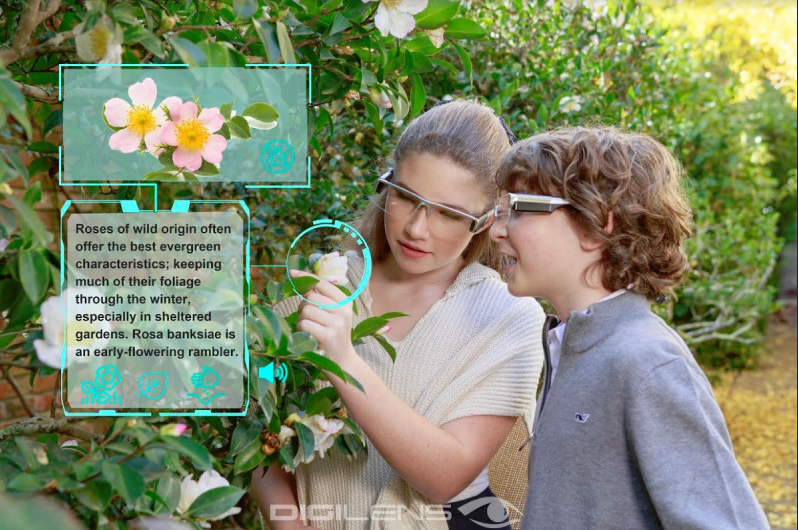AR Display Maker DigiLens Raises $50 Million for Affordable AR Displays
California-based display maker DigiLens announced today that it has closed $50 million Series C funding which was led by Universal Display Corporation’s UDC Ventures along with Continental AG, Samsung Ventures, Sony Innovation Fund, Niantic (Pokemon Go creator) and Mitsubishi’s Diamond Edge Ventures. The funding was oversubscribed and raised more than twice as much as the $22 million the company raised previously, in January 2017. The latest round of funding brings the Sunnyvale-based company’s total venture capital haul to more than $100 million so far.

The Waveguide-builder wants to aggressively price down the cost of this expensive AR hardware component at a time when the AR market is beginning to show some promise. All the hype around the rise of augmented reality has been pegged on the possibility of hardware makers like DigiLens delivering on waveguide displays that will not only be wafer-thin and of much better quality but which will also be affordable enough to make the final product accessible for the mainstream consumer.
A waveguide display is what makes it possible for the projected images to be loaded in from the sides of the sheet glass. This happens due to the etchings in the displays which will bounce off the light around so as to create the complete image projected in front of the user’s eyes. The mechanism of the technology makes it ideal for augmented reality applications which require that very little hardware be in front of the user’s eyes so as to provide them with most comfortable and optimal experience. It is cheaper to implement optics that will reflect images onto a curved display but to create consumer-friendly designs that will take this technology to the mainstream, it’s imperative to develop the waveguide technology and make it more accessible, enabling users to have less hardware and more high-definition images.
While DigiLens will be looking at the AR glasses as its primary market, the waveguide maker is also targeting the automotive market with see-through displays. The company has stated that it is committed to developing the only waveguide which will be able to reach the consumer price point.
The new capital injection from this round of funding will finance its development of waveguide technology which will be put into diverse uses including automobile, military brands, avionics, enterprise and consume applications. The company plans to establish partnerships with some of the leading industries which will enable its display technology to be implemented in diverse form factors.
The Sunnyvale, California-based company ‘s signature product has been its holographic waveguide display which contains a thin-film, laser-etched photopolymer which has been embedded with tiny holograms with mirror-like optics. When a micro-display is streamed through one end of the lens, the optics will turn the light wave and guide it through a surface before it is turned back towards the eye by a second set of optics.

The DigiLens technique was refined close to ten years ago when the company was in partnership with Rockwell Collins for the development of the avionic HUD systems for the US DOD. In the recent years, the company has also come up with a photopolymer material along with a holographic copy process that generates diffractive optics using printers. This technique is much cheaper than using the traditional precision-etching machines. The company is currently a frontrunner in the development of waveguide technology and its innovations which utilize proprietary photopolymer, cutting-edge design software along with an innovative manufacturing technique are expected to get the technology to a consumer-friendly price point soon.
DigiLens showcased the Crystal AR prototype in January which is a glasses-like form factor that enables users to connect to a smartphone, laptop, desktop or a computing puck via a USB-C connection. The prototype deployed two layers for the full-color waveguide which gave a fairly narrow 30-degree field of view. It has the advantage of cost as it is cheaper than the conventional materials. DigiLens believes a product similar to its Crystal AR prototype could one day sell for as low as $500 which is a tenth of the price of some of some of the similar heads-up displays that are currently in the market such as the Magic Leap One Creator Edition or the recently unveiled Microsoft HoloLens 2 which goes for $3500.
DigiLens has also developed a white label solution for automotive manufacturers that is capable of creating a holographic waveguide of roughly a half meter by 320mm long. Those are dimensions that are big enough for the windshield of the vehicle but also small enough that it will fit under the vehicle dashboard. According to DigiLens, it will be possible to generate colored arrows on these displays that transmit instructions to drivers, such as where to turn next thereby ensuring that drivers don’t have to take their eyes off the road when they want to look at their phones.
DigiLens is not planning to manufacture the augmented reality devices on its own. The company is instead intending to license the technology to multiple industries that can use it to create varied devices to meet various user needs. To realize that aim, the company is currently creating nanomaterials to be use for transparent augmented reality displays for a number of its clients.

The Sunnyvale company does not have an exclusive dominance over this domain and faces competition from various players such as WaveOptics, TruLife Optics along with the Apple-owned Akonia Holographics which was acquired by Apple in August in 2018. Akonia pivoted towards displays after spending more than $100 million and a decade trying to build holographic storage. The other serious competitor, WaveOptics, raised $26 million in December 2018 which is to be used in gearing up its processes and infrastructure ahead of the launch of its low-cost augmented reality hardware products. Microsoft and Magic Leap are also developing their own waveguide displays for their upcoming augmented reality headsets.
DigiLens is however betting that products featuring its cutting-edge waveguide display technology will eventually edge out its competitors in the market by offering best-in-class solutions that will meet the AR display needs of multiple industries. The company is planning major launches this year with additional launches planned for 2020 and 2022.
DigiLens is already working with Young Optics, a waveguide manufacturer based in Taiwan. The company has also partnered with the Chinese electronics supplier Malata, ODM as well as Korea’s pico display manufacturer Sekonix which currently manufactures modules that leverage the Texas Instruments DLP Pico products. DigiLens has also entered into a strategic partnership with Mitsubishi Chemical that will see it develop a plastic material to be used in high-refractive waveguide displays that will have superb properties.
https://virtualrealitytimes.com/2019/05/15/ar-display-maker-digilens-raises-50-million-for-affordable-ar-displays/https://virtualrealitytimes.com/wp-content/uploads/2019/05/The-DigiLens-Holographic-technology-can-also-help-users-in-augmenting-their-world-600x398.pnghttps://virtualrealitytimes.com/wp-content/uploads/2019/05/The-DigiLens-Holographic-technology-can-also-help-users-in-augmenting-their-world-150x90.pngAugmented RealityTechnologyCalifornia-based display maker DigiLens announced today that it has closed $50 million Series C funding which was led by Universal Display Corporation’s UDC Ventures along with Continental AG, Samsung Ventures, Sony Innovation Fund, Niantic (Pokemon Go creator) and Mitsubishi’s Diamond Edge Ventures. The funding was oversubscribed and raised more...Sam OchanjiSam Ochanji[email protected]EditorVirtual Reality Times - Metaverse & VR
